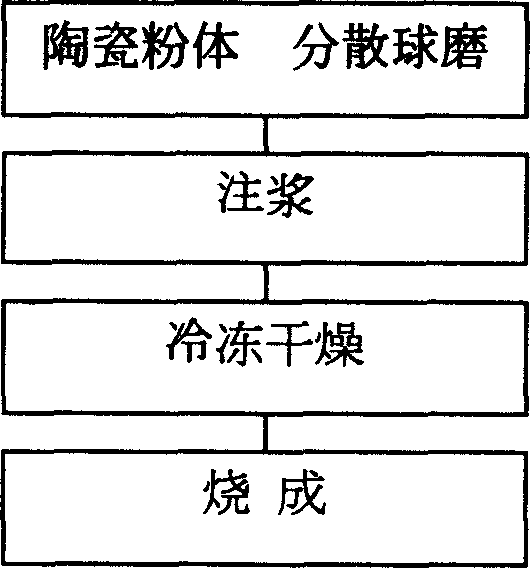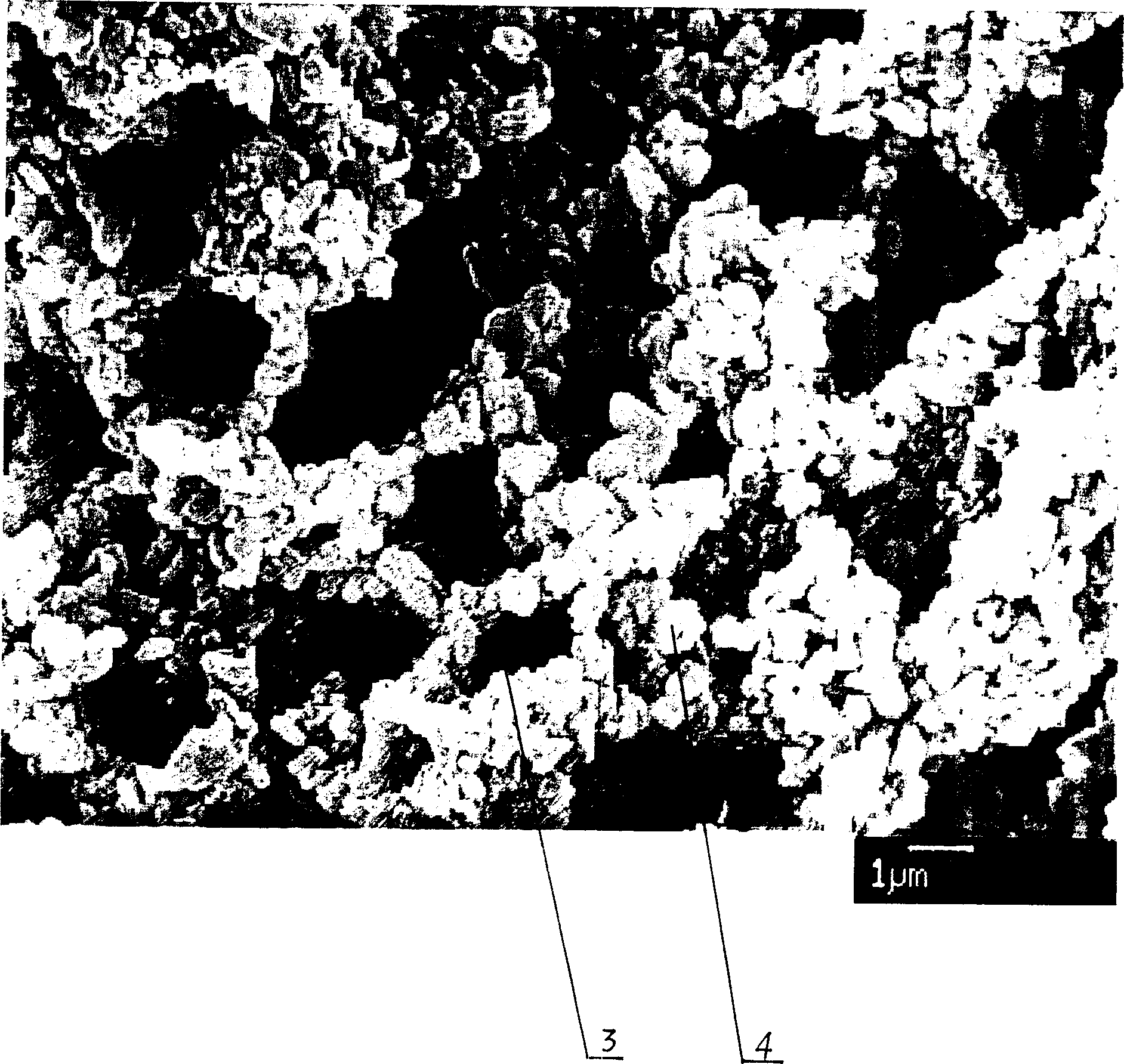Method for preparing poruos material in micro-nano magnitude
A nanoporous, ceramic material technology, applied in ceramic products, other household appliances, household appliances, etc., can solve the problems of difficult to obtain directional porous ceramics, difficult to uniformly disperse pore-forming agents, and restricting the preparation of porous materials, etc. To achieve the effect of easy control of process conditions, consistent pore size and high porosity
- Summary
- Abstract
- Description
- Claims
- Application Information
AI Technical Summary
Problems solved by technology
Method used
Image
Examples
Embodiment 1
[0027] Such as figure 1 As shown, it is a process flow diagram of a preparation method of a micron-nano porous material, and the preparation process of a micron-nano porous material is:
[0028] (1) Preparation of ceramic slurry:
[0029] Mix 27 parts of distilled water and 1 part of dispersant evenly, then add Al with a particle size of 0.8 microns 2 o 3 70 parts of ceramic powder, 2 parts of sintering additive, ball milled for 24 hours;
[0030] (2) Blank forming:
[0031] Pour the mixed ceramic slurry into the mold and put it into the freezer to freeze and shape. The freezing temperature is controlled at -20°C;
[0032] (3) Freeze drying:
[0033] Transferring the frozen ceramic body to a freeze dryer for freeze-drying to obtain a porous body with orientation and uniform distribution;
[0034] (4) Sintering of green body:
[0035] Put the dried ceramic body into a sintering furnace for sintering at a temperature of 1500°C to obtain porous alumina porous ceramics with...
Embodiment 2
[0037] (1) Preparation of ceramic slurry;
[0038] Mix 10 parts of distilled water and 0.5 parts of dispersant evenly, then add Al with a particle size of 0.8 microns 2 o 3 87.5 parts of ceramic powder, 2 parts of sintering additive, ball milled for 24 hours;
[0039] (2) Blank forming:
[0040] Pour the mixed ceramic slurry into the mold and put it into the freezer to freeze and shape. The freezing temperature is controlled at -20°C;
[0041] (3) Freeze drying:
[0042] Transferring the frozen ceramic body to a freeze dryer for freeze-drying to obtain a porous body with orientation and uniform distribution;
[0043] (4) Sintering of green body:
[0044] Put the dried ceramic body into a sintering furnace for sintering at a temperature of 1300°C to obtain a porous alumina ceramic with a porosity of 60%, such as image 3 Shown is the microstructure photo of the porous ceramic. It can be seen from the photo that the pore size 2 of the porous ceramic material 1 is distribut...
Embodiment 3
[0046] (1) Preparation of ceramic slurry;
[0047] Mix 17.5 parts of distilled water and 0.5 parts of dispersant evenly, then add Al with a particle size of 0.8 microns 2 o 3 80 parts of ceramic powder, 2 parts of sintering additive, ball milled for 24 hours;
[0048] (2) Blank forming:
[0049] Pour the mixed ceramic slurry into the mold and put it into the freezer to freeze and shape. The freezing temperature is controlled at -20°C;
[0050] (3) Freeze drying:
[0051] Transferring the frozen ceramic body to a freeze dryer for freeze-drying to obtain a porous body with orientation and uniform distribution;
[0052] (4) Sintering of green body:
[0053] Put the dried ceramic body into a sintering furnace for sintering at a temperature of 1100°C to obtain a porous alumina ceramic with a porosity of 80%, such as Figure 4 Shown is the microstructure photo of the porous ceramic. It can be seen from the photo that the pore size 2 of the porous ceramic material 1 is distribu...
PUM
| Property | Measurement | Unit |
|---|---|---|
| Particle size | aaaaa | aaaaa |
Abstract
Description
Claims
Application Information
 Login to View More
Login to View More - R&D
- Intellectual Property
- Life Sciences
- Materials
- Tech Scout
- Unparalleled Data Quality
- Higher Quality Content
- 60% Fewer Hallucinations
Browse by: Latest US Patents, China's latest patents, Technical Efficacy Thesaurus, Application Domain, Technology Topic, Popular Technical Reports.
© 2025 PatSnap. All rights reserved.Legal|Privacy policy|Modern Slavery Act Transparency Statement|Sitemap|About US| Contact US: help@patsnap.com



